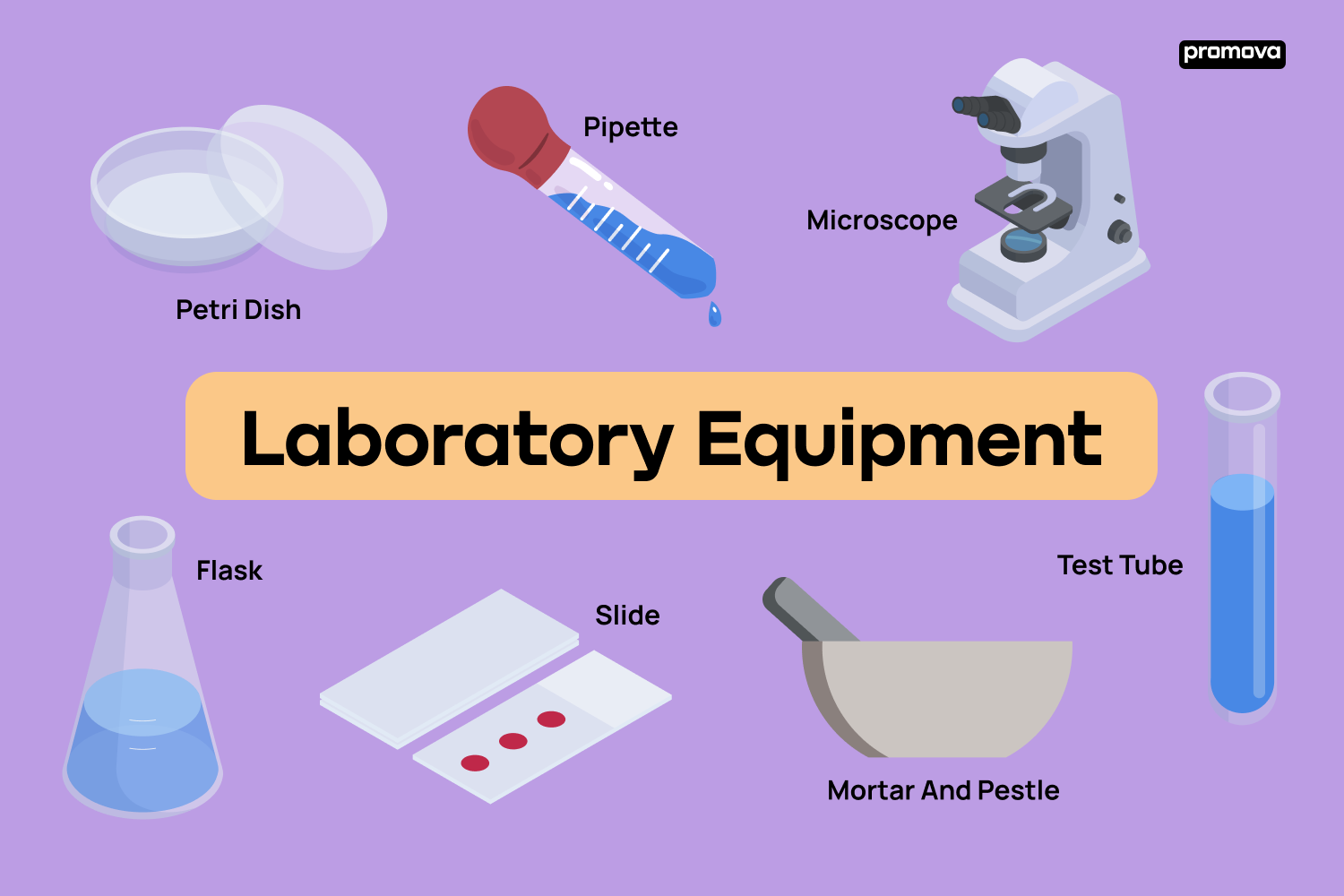Laboratory Equipment Vocabulary
Contents
Learning English is a journey, and understanding the vocabulary of specific domains can be essential for some learners. In this article, you'll dive deep into laboratory equipment vocabulary, which is crucial for anyone pursuing science in an English-speaking context. We will explore common terms used in labs and their meanings.

Basic Laboratory Equipment
Before you step into a lab, it's essential to be familiar with the basic equipment you might encounter. These are the tools that researchers and scientists use daily; understanding them will give you a foundation in laboratory vocabulary.
- Beaker: a cylindrical glass container with a flat bottom; used for measuring and holding liquids.
- Test Tube: a thin, cylindrical glass container; used for holding small amounts of substances for tests.
- Bunsen Burner: scientific equipment that produces a single flame; used for heating substances in a lab.
- Flask: a container, often with a narrow neck, used to hold liquids for laboratory tests.
- Slide: a small flat rectangular piece of glass; used to hold specimens for microscopic examination.
- Stirring Rod: a slender stick used to mix or stir fluids.
- Tripod: a three-legged stand that holds containers above a Bunsen burner for heating.
- Mortar and Pestle: tools used to crush and grind substances into a fine powder.
- Microscope: an instrument that magnifies tiny objects; allows researchers to see small details.
- Petri Dish: a shallow dish; used for growing cultures of microorganisms.
- Pipette: scientific equipment used for transferring a measured volume of liquid.
- Graduated Cylinder: a tall, narrow container with marks; used to measure liquids accurately.
Now, you've familiarized yourself with basic science lab equipment that's foundational for any lab-based study. As you delve deeper into the science world, knowing these terms will give you the confidence to navigate labs with ease.
Advanced Laboratory Equipment
As you advance in the science field, you'll come across more specialized tools. These pieces of equipment are crucial for specific experiments and research. Let's expand your vocabulary by introducing you to these advanced science lab equipment.
- Centrifuge: a machine that spins samples very quickly; separates substances based on density.
- Titrator: an instrument used for precise addition of a solution in titration experiments.
- Gel Electrophoresis System: equipment used to separate DNA, RNA, or protein molecules based on their size.
- Rotary Evaporator: a device used in chemical labs for the efficient removal of solvents from samples.
- Osmometer: an instrument used to measure osmotic strength or concentration in a solution.
- Ultra-low Temperature Freezer: a freezer designed to maintain temperatures as low as -80°C, used for the storage of biological samples.
- Spectrophotometer: an instrument; measures the intensity of light absorbed by a solution.
- Autoclave: a device; used for sterilizing equipment and other objects using high-pressure steam.
- Chromatograph: Equipment; used to separate mixtures into their individual components.
- Electron Microscope: a type of microscope; uses electron beams to create detailed images of tiny structures.
- Fume Hood: a ventilated enclosure; protects the user from inhaling toxic fumes and prevents the spread of harmful substances.
- Hot Plate: a flat heated surface; used for heating substances in containers.
With this list, you've expanded your laboratory vocabulary to include more specialized equipment. Remembering these terms will be instrumental as you engage in more complex scientific studies and discussions.
13
Safety Equipment in the Laboratory
Safety is paramount in any laboratory setting. The following equipment ensures that researchers and scientists can conduct experiments without endangering themselves or others. It's essential for you to know these lab equipment names to prioritize safety.
- Safety Goggles: eyewear; protects the eyes from splashes, fumes, and debris.
- Lab Coat: a protective garment; prevents contamination and protects against spills.
- Gloves: hand coverings; prevent direct contact with harmful substances.
- Fire Blanket: a large piece of fire-resistant material; used to smother flames in case of a fire.
- First Aid Kit: a collection of supplies; used for giving immediate medical treatment.
- Eye Wash Station: laboratory tools that provide a stream of water to rinse the eyes in case of contact with a harmful substance.
- Fire Extinguisher: science lab equipment used to put out small fires in emergency situations.
- Safety Shield: a barrier used to protect against splashes or flying debris during experiments.
- Spill Kit: science lab equipment containing materials to clean up and neutralize chemical spills.
- Safety Shower: a unit providing a flow of water to rinse off a person in case of chemical spills or fires.
- Face Shield: a protective shield worn over the face to protect against splashes or flying particles.
- Respirator: a device worn to protect the wearer from inhaling harmful substances.
Prioritizing safety in a lab is crucial. By knowing and understanding the science tools' names related to safety equipment, you ensure not only your safety but also the well-being of others in the lab.
Conclusion
Congratulations on broadening your laboratory equipment vocabulary! Whether you're a budding scientist, a language learner, or just curious, understanding these terms is valuable. Equip yourself with this knowledge, and you'll navigate any English-speaking lab environment with confidence.



Comments